James Gilliam’s Hand-Crafted Squashed Tomato
Tom Spithaler
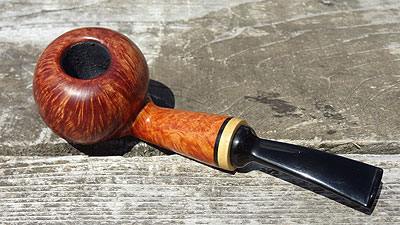
How a shape appears to a pipe-carver as they sit and stare at a raw block of briar is a mystery to many of us who are collectors and smokers. Perhaps not so much to the artisans that are actually doing the carving, but as for me, I’d be lost. Some people though, much like I have read about Michelangelo, see the finished product in the raw material before a hammer, file or chisel is set to the material. Michelangelo is quoted as having said to a contemporary, that it is not that he has to carve the figure out of the marble that stands before him, as much as it is to simply take off the material that he knows does not belong there.
To a pipe carver, they start with a blank slate of a briar block, with a seed started in their mind as to what the finished product is going to look like. For my mother, who has been a gardener all her life (in part by necessity in order to feed five growing children on an income that bordered on the poverty level most of our lives), she would look at an uncultivated piece of land and see vegetables. She’d see rows of carrots, bushels of potatoes, standing rows of corn, vines of pumpkins; squash, and zucchini filled her mind’s eye. On the other hand, what I saw was lots of rock-picking, weeding, watering, and pruning coming, not to mention the harvesting, cleaning, canning, etc that followed in the fall. Of course I never gave much thought to the enjoyment or nourishment I’d gain in eating the wonderful yield of my mother’s vision—but she did. This was her goal. You see she had the vision. I lacked it.
James Gilliam has vision too. Like my mom, he also sees tomatoes where there are none, and before his labor even begins, sees the finished product—in this case a beautiful Bent Squashed Tomato that looks like someone just hand-picked it. This tomato came delivered ready to enjoy. Unlike my mom’s garden, there would be no waiting to know how this tomato turned out.
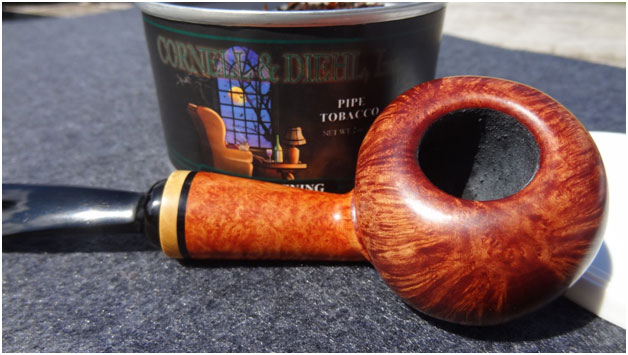
I met James via the internet researching custom handmade pipe crafters. JSEC Handmade Pipes, the name of James’ endeavor, figures well in the minds of a great many people I am in regular contact with regarding the pipe industry. I wrote a short highlight on James and his pipes on my blog, and after a couple of email exchanges thought it was time to make the offer to review one his pipes here on Pipesmagazine.com. I am not sorry to have asked.
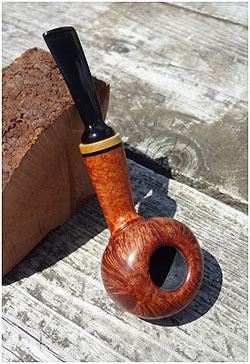 James gave me the choice of several pipes upon which to write this review. Of those suggested he had a couple of favorites, and I had one too. While his favorite was not my favorite, I felt comfortable that the pipe I chose, the beautiful Bent Squashed Tomato that you see here, met with my criteria: A pipe that represents the spirit of the carver’s work. Not necessarily the best pipe they’ve ever made that they want to show off to the Pipesmagazine.com readers, but a pipe that bears with it a bit of the spirit of the pipecrafter himself. James agreed that this was just one such pipe.
James gave me the choice of several pipes upon which to write this review. Of those suggested he had a couple of favorites, and I had one too. While his favorite was not my favorite, I felt comfortable that the pipe I chose, the beautiful Bent Squashed Tomato that you see here, met with my criteria: A pipe that represents the spirit of the carver’s work. Not necessarily the best pipe they’ve ever made that they want to show off to the Pipesmagazine.com readers, but a pipe that bears with it a bit of the spirit of the pipecrafter himself. James agreed that this was just one such pipe.
Interestingly, the tomato that I chose and will review here is the first one James ever made. When I contacted James about this review, I told him that I always ask the pipecrafters how they came to choose what that block of briar would become. Some carvers will let the briar lead them, and in some manner one always has to. But in this case, this pipe was destined for a vegetable debut.
"…frankly, that block was destined to be a tomato from the first time I picked it up in my delicate little hands. Seriously, I saw a Nanna Ivarsson on SmokingPipes.com and thought to myself…why not. I really enjoy making eggs and fish, if you look at most of the pipes I’ve made they are all a variant of those two shapes, except for this one and some of the works I’m doing right now. Just trying to expand my repertoire, and making a round bowl has always given me fits. After seeing Nanna’s I thought it was something that I could pull off."
James is a retired Cryptologic Technician (CTRC) from the US Navy. He has smoked pipes traveling from his hometown in the farms and oil fields of South and West Texas, and all over the world via the decks of Uncle Sam’s Navy. A forced need for repairs first got James involved in working on pipes, and it just seemed to evolve into making them from scratch. James puts it this way:
"There is nothing like a strong sea wind blowing through the starboard break (the smoke deck on my last ship) that causes your tobacco to burn just a little quicker than normal. Shortly after repairing several of my pipes I decided that if I can repair them I can also make them."
Travel the world he did, and make pipes he does. Apparently with equal fervor and success.
This pipe arrived without fanfare from the postal service in a non-descript white box. As I opened the box, the first thing I knew about James that I had not already known, is that he smokes Peterson pipes as well as his own. The Peterson box I returned to James, as it is a box for a pipe that has some sentimental value to him. All the same, he wanted to make sure the Tomato arrives safely, even if it meant sacrificing this box.
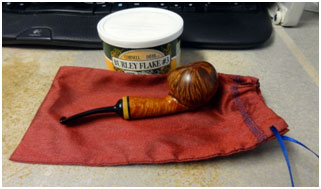 The Tomato was fastened inside what appears to be a hand-sewn satin sock of burgundy color. The sock has ornate stitching at the top in a navy blue tone with a knotted satin tie to match. The sock is of ample size, and the Tomato slides in and out with ease, as one would expect from a satin or nylon sock. This may seem trivial to be part of the review of a hand-crafted pipe, but few things bother me, or trouble other pipe collectors than a custom hand-made pipe delivered in a sock that doesn’t fit, or is of the quality that doesn’t match the pipe itself. I’m a big fan of leather, but the chemicals used to create leather can sometimes be harsh on a briar’s finish. While a satin sock is thin, and in and of itself offers little protection for the pipe from bumps and bruises, the pipe fits in it well, and when displayed on the sock ads a nice color match to the pipe itself.
The Tomato was fastened inside what appears to be a hand-sewn satin sock of burgundy color. The sock has ornate stitching at the top in a navy blue tone with a knotted satin tie to match. The sock is of ample size, and the Tomato slides in and out with ease, as one would expect from a satin or nylon sock. This may seem trivial to be part of the review of a hand-crafted pipe, but few things bother me, or trouble other pipe collectors than a custom hand-made pipe delivered in a sock that doesn’t fit, or is of the quality that doesn’t match the pipe itself. I’m a big fan of leather, but the chemicals used to create leather can sometimes be harsh on a briar’s finish. While a satin sock is thin, and in and of itself offers little protection for the pipe from bumps and bruises, the pipe fits in it well, and when displayed on the sock ads a nice color match to the pipe itself.
My initial impressions were different than I anticipated. I was slightly taken aback. While the pipe looked absolutely beautiful in the images on James’ web-site, I was not ready for the severity of the contrast of the colors on the pipe. But I was glad!
The imagery on the JSEC web site is very good, but a 10 or 15 megapixel image does not translate well onto a 72dpi web based graphic. In the process of shrinking the size and lowering the contrast, some clarity and coloration is lost. Anyone who dabbles in digital imagery, works on web sites or blogs, or just simply posts pictures to Facebook surely knows what I am talking about.
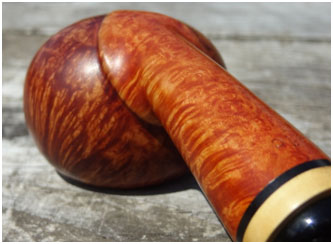 The dark brown stain on the bowl area of the stummel wrapping around to the bottom is a very dark brown, almost walnut stain, albeit opaque enough to really show the outstanding flame-style grain. Where the bowl merges into the shank, this tomato is rather ornately fashioned. It is clearly a hand-carved ‘spade’ shape, and the color changes dramatically and sharply into a light mahogany that seems to be back-lit by a bright yellow. The transition in color is every bit as powerful and beautifully done as the transition of the bowl to the shank. It speaks of elegance, charm, and a patient appeal to the briar in order to coerce it into the shape that we see here. This is perhaps the one point on the pipe that most reveals the superb engineering and carving skills of James.
The dark brown stain on the bowl area of the stummel wrapping around to the bottom is a very dark brown, almost walnut stain, albeit opaque enough to really show the outstanding flame-style grain. Where the bowl merges into the shank, this tomato is rather ornately fashioned. It is clearly a hand-carved ‘spade’ shape, and the color changes dramatically and sharply into a light mahogany that seems to be back-lit by a bright yellow. The transition in color is every bit as powerful and beautifully done as the transition of the bowl to the shank. It speaks of elegance, charm, and a patient appeal to the briar in order to coerce it into the shape that we see here. This is perhaps the one point on the pipe that most reveals the superb engineering and carving skills of James.
Moving up shank from the tomato shaped bowl, we run into some more interesting areas. The shank is just over a half inch in diameter, but grows as it travels away from the bowl and towards the stem. The gradual expansion in diameter does not detract from the pipe, or interrupt the flow as you scan one end to the other. As a matter of fact, it does just the opposite. It adds dramatically to the esthetics of the pipe most especially when you get to the end tipped in a bright boxwood ferrule with a black band as a foundation. In running my fingers around the end of the shank, the transition from the briar to the accent ring through to the boxwood is virtually imperceptible. If I use the tip of a fingernail, and move slowly, I can feel a slight nudge, but that’s it. The sanding and finish fitting of these separate and contrasting elements are fantastic. The boxwood really pops on the end of that expanding shank; what a great look!
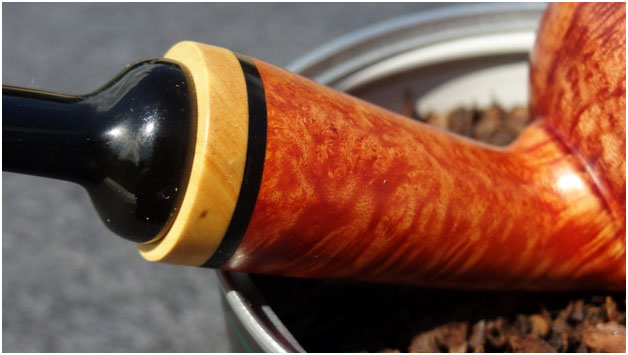
The mortise is tight. Not too tight mind you, but tighter than some others that I have. However, this is not troubling to me in the least. I do, like most pipe smokers, desire to have a tighter mortise fit. The junction of the stem and the shank is one of the most important characteristics of any pipe when it comes to ‘smokeability’.
This tenon is unlike most that James makes. On this Bent Squashed Tomato, James chose to make a polyoxymethylene (also known by its DuPont name, Delrin®) insert for the German Ebonite stem. Delrin was specifically engineered to be used in parts and fittings that require close tolerances, high stiffness, low friction and excellent dimensional stability. Using it for pipe tenons is a perfect use for this material. When I asked James about it he responded:
"I don’t do this on many pipes. I saw a Wayne Teipen pipe with a Delrin insert and just wanted to try it out. Since this one I’ve done it for several other pipes. I have one morta blowfish that I’ve done it with and there are a few others. Honestly, I like the idea, but it doesn’t get too many positive reactions, I’ve shown it to some people over where I live and they look at me kind of confused and ask why? When I explain it I’m not sure it’s fully understood, and accepted with quiet resistance. In the future it is probably only something that will be done upon request or when a pipe is destined for my own pipe rack."
 For me it is excellent, and I love it! As a matter of fact I have a pipe for myself that I’m will be commissioning soon, and part of my request is for a Delrin® insert. That’s how much I love it, and I owe James for making this one so good. Even though James may not be using Delrin regularly on production pipes, he doesn’t have to worry about explaining it to me. It provides the tighter fit I’m looking for, but with the viscosity of the delrin, a slight twist and out comes the stem. Of course, James would be foolish not to consider the customers opinions, and so he does by making this available upon request. While for me this is a progressive step forward in materials usage on modern pipes, tradition, especially in this hobby/industry runs thick as blood. Every writer and pipecrafter is wise to consider it. Well spoken Mr. Gilliam.
For me it is excellent, and I love it! As a matter of fact I have a pipe for myself that I’m will be commissioning soon, and part of my request is for a Delrin® insert. That’s how much I love it, and I owe James for making this one so good. Even though James may not be using Delrin regularly on production pipes, he doesn’t have to worry about explaining it to me. It provides the tighter fit I’m looking for, but with the viscosity of the delrin, a slight twist and out comes the stem. Of course, James would be foolish not to consider the customers opinions, and so he does by making this available upon request. While for me this is a progressive step forward in materials usage on modern pipes, tradition, especially in this hobby/industry runs thick as blood. Every writer and pipecrafter is wise to consider it. Well spoken Mr. Gilliam.
The stem itself is beautifully polished and smooth as glass. The button is squared off from the front, tall (akin to what some call a "grasping" bit), and yet very smooth and comfortable. The Tomato does not weigh a great deal, tipping the scales at a rather slight 51.75 grams. Personally, I found the Tomato to fit well in my mouth and it was quite comfortable. It is full bodied if based on the outside dimensions of the bowl alone, but not so heavy that it becomes uncomfortable hanging from your mouth for a minute or so with the tall button hooked on your most stable tooth.
The angle (roughly a ¼ bent pipe to begin with) is almost perfect when considering the curve in the mouthpiece. Hanging from my mouth it rests comfortable on my furry chin. So, that being said, if this pipe were not a comfortable fit for you, it’s nothing that 3 months worth of not shaving and a couple of extra cheeseburgers per week wouldn’t easily solve!
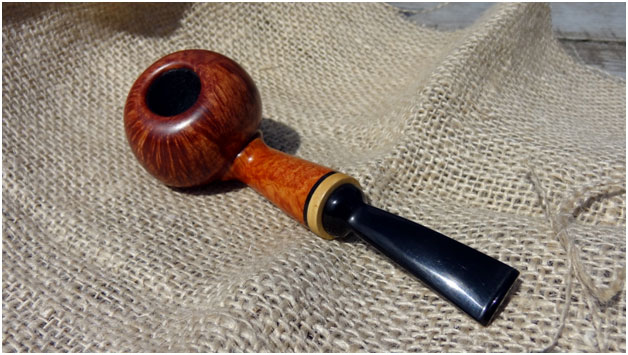
This pipe is not a mini by any stretch. I’d consider it a full-size pipe and yet far short of a jumbo. The pipe is 5.5" long, with the stummel measuring in a 3.5" itself. The bowl diameter checks in at .68", but we have to take into consideration a rather thick bowl coating that feels a lot like a 220 grit sanding paper. When I asked James about the bowl coating, he said,
"95% of all my pipes have bowl coatings. The bowl is still sanded out prior to coating, but I think it gives the pipe a more classic look.
Of course a commissioned pipe has the option of no coating. I’m really personally undecided as to the real benefit of the coating except for aesthetics. I know there is quite a bit of debate about to-or not to.
It’s not a private formula, just the way I was shown by a pipemaker close to where I live. I’m experimenting with getting it thinner, but the tomato was one of the first 10 or so pipes I actually coated, so it came out a little thicker."
I’m with James on this issue. I’m personally undecided as well as to the aesthetics of the bowl coating. I understand completely the intent for it being there; to add a protective coating to the briar to protect it from scorching until a layer of natural caking can be applied from the tobacco by regular smoking. But to me, and to many others, a raw bowl with the natural wood on display is a pleasant sight to behold as well.
I first smoked this pipe on a quiet Saturday afternoon. It was cool and overcast in the Great Northwest, in other words, just like every other day, and the perfect day for a pipe smoke. I chose for this occasion, a new blend from Cornell & Diehl, Burley Flake #3. A knife cut blend heavy on Burley (imagine that…), some Virginia and Perique. After a quick rub out of the cut C&D #3, I filled the bowl and lit it with a soft butane lighter that throws a large flame, but one that is not too hot or forceful. Two quick clicks later, and I had a flaming bowl of fresh tobacco wafting into the evening air.
The draw on the JSEC Squashed Tomato was soft, full and smooth. As I shared before, this little piece of vegetable art turned smoking pipe sat so nicely in my mouth. Not too heavy and very comfortable as a pipe for sitting and reading. The bit was yielding and felt natural in my lips and never felt like I needed to take the pipe put of my mouth between draws. It was just perfectly comfortable sitting there for as long as I liked.
|
What happened next came completely natural and yet was revealing as to how much I really liked this pipe. As it turned out, I was at that moment not a fan of the C&D Burley #3.* It was robust and a little warm for an evening smoke. I finished that bowl, and filled it again almost immediately with the Cornell & Diehl Autumn Evening blend which I knew to be a favorite relaxation blend if mine, and wa-lah! I was smoking my second bowl on this pipe in no time, and enjoying my evening supremely! |
|
I enjoy seeing the pictures of JSEC pipes that James posts on forums and his web site typically resting by a British World War I ordnance fuse cap recovered from around Flanders Field in Ieper Belgium. As a former Infantry Soldier, I happen to like things that go ‘boom!’ To tie in the naval theme of his life into his pipes, James sometimes uses an anchor as a stamp along with his family’s initials. His son designed the two stamps a few years ago and each initial represents an individual of his family. This handsome and great smoking Squashed Tomato carries James’ alternative markings of a stylistic application of those initials. I asked James if this was indicative of any grading system, and he replied:
"No, I dabbled with grading for a while, based it on my two different stamps, but got tired of that… my "grading" experiment kind of waned and I normally use my two different stamps as I see fit. Since I was in the Navy for 20 years, the sea is kind of in my blood, so if I’m doing something really nautical I’ll use the stamp with the anchor on it, and vice versa if the pipe is more along the lines of something more elegant the other stamp is used."
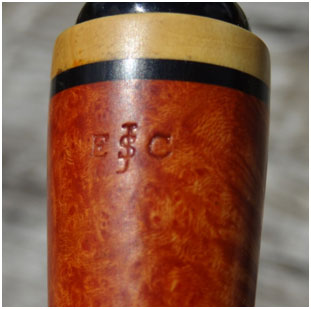 With that knowledge in mind, one can derive from my opinion that I am in agreement with James. This is an elegant pipe, and a piece of art worthy of great praise. I am in the process of building a ‘pipe for every day of the week’ collection. I’m feeling like the Bent Squashed Tomato will become ‘Sunday’. Fancy enough for church, practical, and ready for a nice relaxing day. Grace in the art applied, and blessings to the smoker received – with great thanks.
With that knowledge in mind, one can derive from my opinion that I am in agreement with James. This is an elegant pipe, and a piece of art worthy of great praise. I am in the process of building a ‘pipe for every day of the week’ collection. I’m feeling like the Bent Squashed Tomato will become ‘Sunday’. Fancy enough for church, practical, and ready for a nice relaxing day. Grace in the art applied, and blessings to the smoker received – with great thanks.
As a result of thoroughly critiquing of this JSEC Bent Squashed Tomato and putting it to its intended use, I found the work of James Gilliam to be excellent! The pipe fits my hand perfectly, and is somewhat small for my normal pipe selection (See my Chubby Billiard review…), but does the job of a full size pipe like a boss. The briar chosen revealed no flaws, the grain is superb for the application, the staining work is stunning in choice and contrast, finish is smooth and polished perfectly, and the engineering is top-notch. There was nothing not to like. I find myself frequenting the JSEC on-line store to see what else one might gather into the fold. James creations sell in the $250-$350 price range, and are by my recollection worth every penny asked.
In life, to the chef the tomato is a rich vegetable that has great variety and versatility. My mom spent more time working on growing tomatoes than any other veggie in the garden. It has elegance on the vine, and is used to add flavor and color to a dish and to life. Some societies whole culture as it relates to food and fellowship revolve around tomatoes. Like those cultures, now that this Tomato has been ‘tasted’, I realize that it too adds great variety and versatility to my life. It is now hard to imagine life without it. Bon Appétit!

Tom Spithaler is an Award Winning PSEA writer and member of the American Press Association who has cut his professional teeth in the outdoor and firearms media. Tom currently operates Born Again Briar, a small pipe sale and restoration business, blogs at www.briarmeditations.blogspot.com, and operates Spithaler Media Services, a dba of Paraklete Consulting Services, LLC. A husband of 20 years and father of three, Tom currently resides in Bonney Lake, WA. Contact: tom@bornagainbriar.com. |

















That is a fine looking tomato.
Thanks for yet another wonderful article, Mr. Spithaler! It’s quite evident that, like me, you form a bond with the pipes you love — and this one brings a lot to the relationship. It was a most enjoyable read; and the photography is excellent.